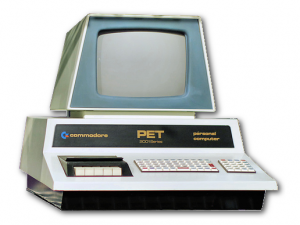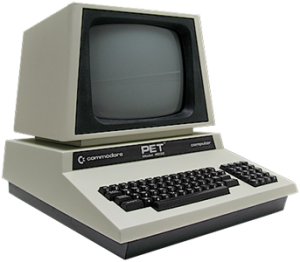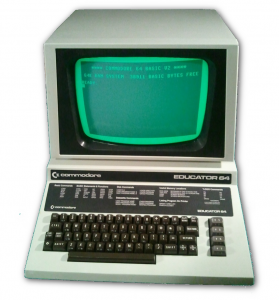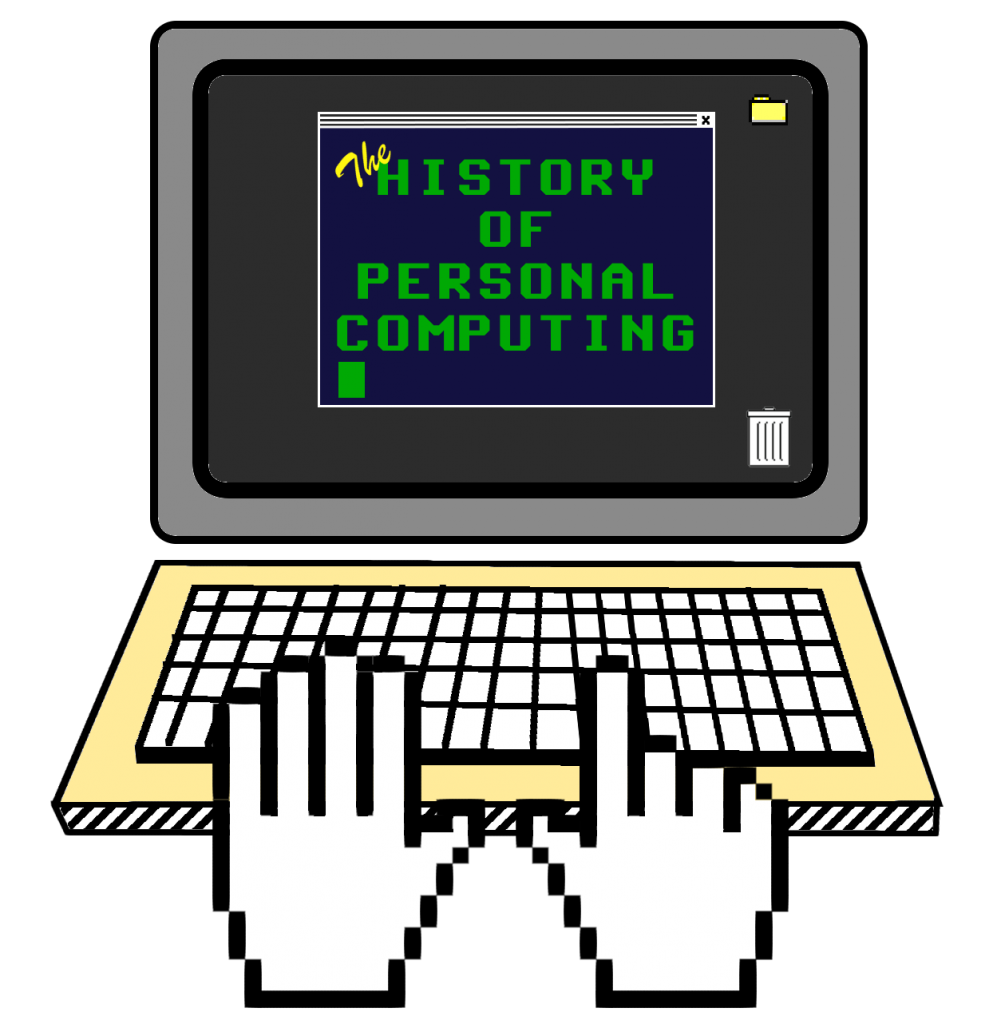Commodore PET
So far on the History of Personal Computing website, we have covered two of the three computers that are a part of the Personal Computer Trifecta. We covered the Apple II and the Radio Shack TRS-80 Model I. We have covered these computers in the order of their release date. Since the term “Trifecta” denotes three of something, that leaves the third and final “home computer system” to be released in the same year as the others. As the world was finally getting over the hype of the 1970’s quintessential “Pet Rock”, Commodore began producing the first “PET Computer”, known as the Commodore PET 2001.
| Listen to our podcast episode about the Commodore PET computer here |
The Commodore PET 2001 was the third in a line of what we refer to as the first, true “out-of-the-box” consumer computers. All three were introduced in 1977, and all three were paradigm-changing. Arguably, these were the first home or educational computers that could be purchased, taken out of their boxes, setup, plugged-in and then used in some immediate productive way. One thing that made the Commodore PET 2001 unique from the other two was that it was fully an “all-in-one” computer. In one combined unit, it had the computer, the screen, the keyboard AND a tape drive for input. By the end of 1977, the Apple II, Radio Shack TRS-80 Model I and Commodore PET 2001 had laid the path for the future of the personal computer. Sales of new and improved consumer computers, mostly with plastic cases would rise and rise, while the sales of the once dominant S-100 hobbyist or business-class computers, would soon plateau, then begin to decline.
Introduction
During the 1970s, Commodore competed with many other electronics companies selling calculators based on Texas Instruments (TI) chips. In 1975, TI increased the price of their components to the point where the chip set cost more than what they sold one of their calculators for. This almost immediately froze most of their competitors out of the market. However, Commodore competitively responded to this by searching for a chip set they could purchase outright. And they found one with the company MOS Technology, which brought with it a valuable bonus, the 6502 microprocessor, which MOS was furiously trying to bring to market. The acquisition also brought with it Chuck Peddle and his KIM-1 single-board computer kit based on the 6502. At Commodore, Peddle convinced Jack Tramiel that calculators were a dead-end market. So Tramiel commanded Peddle, along with engineers Bill Seiler and John Feagans to create a computer in six months for the Consumer Electronics Show (CES). The PET 2001 was announced at the Winter CES in January 1977 and the first 100 units were shipped later that year in October. The PET was remained in a back-order status for months.
The Company
Commodore was founded in Toronto in 1954 as the Commodore Portable Typewriter Company by Polish immigrant and Auschwitz survivor Jack Tramiel. By the late 1950s, an onslaught of Japanese products forced most other North American typewriter companies to go out of business, but Tramiel saw a trend and started producing adding machines. They remained successful and changed their name to Commodore Business Machines, Inc. (CBM). In the late 1960s, Japan again started impeding on Commodore’s market, so Tramiel traveled to Japan in order to try and learn how to better compete. Instead, he returned with the idea of producing electronic calculators. He had done it again, and the company prospered. Unfortunately, by 1975, Texas Instruments, the main supplier of electronic calculator parts, entered the market, introducing calculators that were priced less than Commodore could even build them. So Jack Tramiel turned his big ship again, and the company began producing computers. The company again prospered, but by January 1984, Tramiel resigned after years of intense disagreement with the chairman of the board, Irving Gould. Gould replaced Tramiel with Marshall F. Smith, a steel executive who had no experience with computers or consumer marketing. Even though Commodore introduced what was arguably one of the best computers on the market, for the price, the Amiga, the company never really prospered again, and started a long, slow decline (not in product quality, but in sales and success). The Amiga quickly fell behind its two real competitors, the IBM PC and the Macintosh. We will be covering Amiga more in a future episode. Commodore declared bankruptcy on April 29, 1994 (read more about the post-Commodore era here: https://en.wikipedia.org/wiki/Commodore_International#Post-Commodore_International.2C_Ltd.). In July of 1984, Tramiel purchased Atari’s Consumer Division (which included the console and home computer departments) from Warner Communications. More on that in a later Atari episode as well.
The system specs for the Commodore PET are as follows:
- CPU: 1 MHz 6502
- RAM: 4 or 8 kB
- ROM: 18 kB, including BASIC 1.0 (disk drives not supported on the original 2001)
- Video: discrete TTL video circuit, 9″ monochrome monitor (blue phosphor on the original 2001, 40×25 character display
- Sound: none / single piezo “beeper” (optional external speaker driven by MOS 6522 CB2 pin)
- Ports: 2 MOS 6520 PIA, MOS 6522 VIA, 2 Datassette (1 used / 1 on the back), 1 IEEE-488
- 69 key chiclet keyboard and built-in Datassette
Other models of the Commodore PET line include:
- 2001-N, 1979
- standard green-phosphor monitor
- conventional, full-sized keyboard
- no more built-in cassette recorder
- European models
- CBM 3000 Series
- 4000-series, 1980
- larger 12″ monitor with a redesigned CRT controller
- enhanced BASIC 4.0
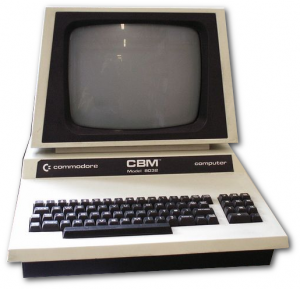
Commodore PET 8032 – The 4000 and 8000 series of PET computers had very similar cases with minor label variations
- 8000-series
- 80×25 character display
- 1-channel speaker for sound generation
- “The killer POKE”
- software incompatibilities with programs designed for the 40 column screen
- SP9000 or SuperPET, 1981
- MOS 6502 and Motorola 6809 microprocessors
- 96 kB RAM
- BASIC 4.0 in ROM for the 6502
- APL, COBOL, FORTRAN, Pascal and a 6809 assembler on floppies for the 6809
- CBM-II or B series
- Not very successful and quickly discontinued.
- Educator 64, 1983
- Actually not a PET model, but a Commodore 64 in a PET-styled all-in-one case.
- Significant successors
- VIC-20, 1980
- Commodore 64, 1982
- Commodore 128, 1985
- Amiga 1000, 1985
The following drives came out throughout the original lifespan of the various PET production models:
- Commodore 2031 single disk drive and 4040 dual disk drive.
- Each drive stored 170K on 5.25” disks and were compatible to the future Commodore 1541 disk drive standard.
- There were the 8000 series disk drives which had larger capacity drives.
- The 8050 held 500K on a single side of a disk
- The 8250 held a whopping 1MB on a dual sided disk.
- If you were still clinging onto the 8” disk standard of the time, you could get the 8280 dual 8” disk drive that stored 500K on a single side of a disk.
- For hardcore data storage needs, you could get the 9060 (5MB) or 9090 (7.5MB) hard drives.
- Commodore also offered the 8024 printer, which supported 132 columns
- For CAD and other vector based printing, there was the Commodore 8075 plotter
- Since the PET had an IEEE-448 interface for peripherals, this opened up the option to purchase various third party peripherals. It would most likely be up to the user to figure out how to output to those devices.
The PET legacy
- The Commodore PET opened up some alternative ideas in personal computing. For instance, graphics on a personal computer were rather resource intensive, especially if bitmapped screens were involved in the process.Commodore introduced a rudimentary set of character graphics. These graphics allowed the user to create simple screen designs using shapes that were the same size and area as a regular ASCII character. These character blocks included shapes such as the four playing card suits, half-blocks, quarter-blocks, and angled lines. These shapes made it easy to create simple full screen designs without having to manage thousands of individually set pixels. The user could type the characters directly from the keyboard.All of the special graphics were mapped into the 256 character ASCII set of industry standards character codes. The resulting set of characters were colloquially called, PETSCII, named for the PET computer. Commodore used this same character enhancement on the remaining line of 8-bit computers that they developed in the future.
- Another important legacy sparked by the Commodore PET was the vertical integration aspect of its creation. In many of the previous personal computers we’ve discussed so far, companies would typically design their computer systems around third party components. This included the CPU itself and much of the other supporting components. Next to RAM at the time, CPUs were a large part of the manufacturing cost because they needed to be sourced from component manufacturers. The same was true for custom ROMs and other specialty components.As mentioned earlier this post, Commodore bought MOS Technologies. Not only was Commodore the only legal manufacturer of the 6502 at this point, but they also used MOS facilities to create many of the other components in the PET. This allowed Commodore to price the PET very competitively yet still earn decent profits. What’s more, guess which computer manufacturer was also using the 6502 as its CPU. Apple and Atari! So basically, Commodore was selling CPUs to its competitors.
- The Commodore PET encouraged a number of people in Canada to create a subscription based independent magazine for PET owners, called The Transactor. Initially targeting PET user groups, The Transactor was geared toward Commodore computer hacking. In essence, it gave the “turn-key home computer owner” insight into the hardware hacking experiences of computer owners in the earlier years of computing.The Transactor had an 11 year run through a total of three publishing companies and provided hardware insight into the later Commodore computer models.
